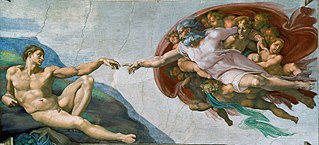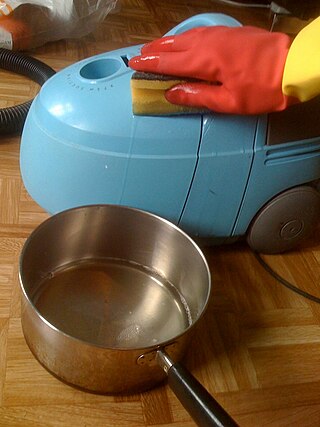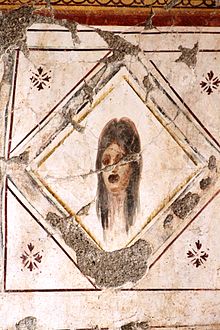
Fresco is a technique of mural painting executed upon freshly laid ("wet") lime plaster. Water is used as the vehicle for the dry-powder pigment to merge with the plaster, and with the setting of the plaster, the painting becomes an integral part of the wall. The word fresco is derived from the Italian adjective fresco meaning "fresh", and may thus be contrasted with fresco-secco or secco mural painting techniques, which are applied to dried plaster, to supplement painting in fresco. The fresco technique has been employed since antiquity and is closely associated with Italian Renaissance painting.

Oil painting is a painting method involving the procedure of painting with pigments with a medium of drying oil as the binder. It has been the most common technique for artistic painting on canvas, wood panel or copper for several centuries, spreading from Europe to the rest of the world. The advantages of oil for painting images include "greater flexibility, richer and denser colour, the use of layers, and a wider range from light to dark". But the process is slower, especially when one layer of paint needs to be allowed to dry before another is applied.

Paint is a material or mixture that, when applied to a solid material and allowed to dry, adds a film-like layer. As art, this is used to create an image or images known as a painting. Paint can be made in many colors and types. Most paints are either oil-based or water-based, and each has distinct characteristics.

Plaster is a building material used for the protective or decorative coating of walls and ceilings and for moulding and casting decorative elements. In English, "plaster" usually means a material used for the interiors of buildings, while "render" commonly refers to external applications. The term stucco refers to plasterwork that is worked in some way to produce relief decoration, rather than flat surfaces.

Calcium hydroxide (traditionally called slaked lime) is an inorganic compound with the chemical formula Ca(OH)2. It is a colorless crystal or white powder and is produced when quicklime (calcium oxide) is mixed with water. Annually, approximately 125 million tons of calcium hydroxide are produced worldwide.

Whitewash, calcimine, kalsomine, calsomine, or lime paint is a type of paint made from slaked lime (calcium hydroxide, Ca(OH)2) or chalk (calcium carbonate, CaCO3), sometimes known as "whiting". Various other additives are sometimes used.

Tarnish is a thin layer of corrosion that forms over copper, brass, aluminum, magnesium, neodymium and other similar metals as their outermost layer undergoes a chemical reaction. Tarnish does not always result from the sole effects of oxygen in the air. For example, silver needs hydrogen sulfide to tarnish, although it may tarnish with oxygen over time. It often appears as a dull, gray or black film or coating over metal. Tarnish is a surface phenomenon that is self-limiting, unlike rust. Only the top few layers of the metal react. The layer of tarnish seals and protects the underlying layers from reacting.

Lime is an inorganic material composed primarily of calcium oxides and hydroxides. It is also the name for calcium oxide which occurs as a product of coal-seam fires and in altered limestone xenoliths in volcanic ejecta. The International Mineralogical Association recognizes lime as a mineral with the chemical formula of CaO. The word lime originates with its earliest use as building mortar and has the sense of sticking or adhering.

Fresco-secco is a wall painting technique where pigments mixed with an organic binder and/or lime are applied onto dry plaster. The paints used can e.g. be casein paint, tempera, oil paint, silicate mineral paint. If the pigments are mixed with lime water or lime milk and applied to a dry plaster the technique is called lime secco painting. The secco technique contrasts with the fresco technique, where the painting is executed on a layer of wet plaster.

Lime plaster is a type of plaster composed of sand, water, and lime, usually non-hydraulic hydrated lime. Ancient lime plaster often contained horse hair for reinforcement and pozzolan additives to reduce the working time.
Silicate mineral paints or mineral colors are paint coats with mineral binding agents. Two relevant mineral binders play a role in the field of colors: Lime and silicate.

Sinopia is a dark reddish-brown natural earth pigment, whose reddish colour comes from hematite, a dehydrated form of iron oxide. It was widely used in Classical Antiquity and the Middle Ages for painting, and during the Renaissance it was often used on the rough initial layer of plaster for the underdrawing for a fresco. The word came to be used both for the pigment and for the preparatory drawing itself, which may be revealed when a fresco is stripped from its wall for transfer.

Sittanavasal Cave is a 2nd-century Tamil Śramaṇa complex of caves in Sittanavasal village in Pudukottai district of Tamil Nadu, India. Its name is a distorted form of Sit-tan-na-va-yil, a Tamil word which means "the abode of great saints".

The conservation-restoration of the frescoes of the Sistine Chapel was one of the most significant conservation-restorations of the 20th century.

Cleaning agents or hard-surface cleaners are substances used to remove dirt, including dust, stains, foul odors, and clutter on surfaces. Purposes of cleaning agents include health, beauty, removing offensive odor, and avoiding the spread of dirt and contaminants to oneself and others. Some cleaning agents can kill bacteria and clean at the same time. Others, called degreasers, contain organic solvents to help dissolve oils and fats.

Conservation and restoration of ceramic objects is a process dedicated to the preservation and protection of objects of historical and personal value made from ceramic. Typically, this activity of conservation-restoration is undertaken by a conservator-restorer, especially when dealing with an object of cultural heritage. Ceramics are created from a production of coatings of inorganic, nonmetallic materials using heating and cooling to create a glaze. These coatings are often permanent and sustainable for utilitarian and decorative purposes. The cleaning, handling, storage, and in general treatment of ceramics is consistent with that of glass because they are made of similar oxygen-rich components, such as silicates. In conservation ceramics are broken down into three groups: unfired clay, earthenware or terracotta, and stoneware and porcelain.

Work on the conservation and restoration of Leonardo da Vinci's The Last Supper mural, much of it more harmful than helpful, has been carried out over many centuries, and continues. Completed in the late 15th century by the Renaissance artist Leonardo da Vinci, the mural is located in the refectory of the Convent of Santa Maria delle Grazie, Milan, Italy. The Last Supper was commissioned by Ludovico Sforza, Duke of Milan in 1495, as part of a series of renovations to the convent with the intention that the location would become the Sforza family mausoleum. Painting began in 1495 and continued until 1498.

The conservation and restoration of paintings is carried out by professional painting conservators. Paintings cover a wide range of various mediums, materials, and their supports. Painting types include fine art to decorative and functional objects spanning from acrylics, frescoes, and oil paint on various surfaces, egg tempera on panels and canvas, lacquer painting, water color and more. Knowing the materials of any given painting and its support allows for the proper restoration and conservation practices. All components of a painting will react to its environment differently, and impact the artwork as a whole. These material components along with collections care will determine the longevity of a painting. The first steps to conservation and restoration is preventive conservation followed by active restoration with the artist's intent in mind.
The conservation and restoration of Pompeian frescoes describes the activities, methods, and techniques that have historically been and are currently being used to care for the preserved remains of the frescoes from the archeological site of Pompeii, Italy. The ancient city of Pompeii is famously known for its demise in A.D. 79 after the fatal eruption of Mount Vesuvius wiped out the population and buried the city beneath layers of compact lava material. In 1738, King Charles III or Charles of Bourbon, began explorations in Portici, Resina, Castellammare di Stabia, a Civita, where it was believed that the ancient cities of Pompeii, Stabiae, and Herculaneum were buried beneath. The first phase of the excavations at Pompeii started in 1748, which led to the first conservation and restoration efforts of the frescoes since their burial, and in 1764, open-air excavations began at Pompeii. Pompeii has a long history of excavation and restoration that began without a strong foundation or strategy. After centuries of cronyism, recurring financial shortages, and on-again-off-again restoration, the city's frescoes and structures were left in poor condition. In 1997, Pompeii was added to the UNESCO List of World Heritage Sites.

Mineral painting or Keim's process, also known as stereochromy, is a mural or fresco painting technique that uses a water glass-based paint to maximize the lifetime of the finished work.
























